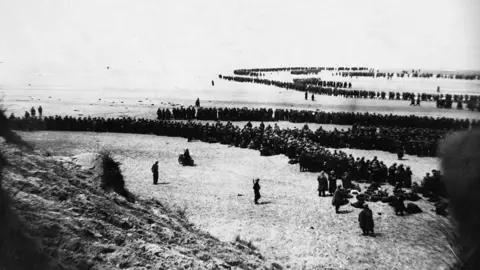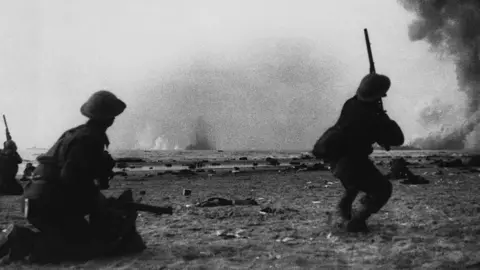'These little ships are our last link to the war'
 Getty Images
Getty ImagesOn 14 May 1940, the BBC made the following announcement:
"The Admiralty have made an order requesting all owners of self-propelled pleasure craft between 30' and 100' in length to send all particulars to the Admiralty within 14 days from today if they have not already been offered or requisitioned."
It set into motion Operation Dynamo, which saw hundreds of thousands of Allied troops evacuated from northern France during World War Two.
Hundreds of small boats flocked to the south-east coast, where they were used mostly by the Royal Navy to help bring soldiers back to Kent.
'Incredibly scary time'
Jason Carley owns the Naiad Errant, which he told the BBC rescued the crew of a French destroyer that had been sunk by the Germans on its way to Dunkirk.
His boat, built in Littlehampton in 1939, also shuttled troops back and forth from the French shore to larger navy ships out at sea, and had eight soldiers onboard when it later docked in Ramsgate.
"Could you imagine how difficult it would have been doing that trip at night while being at times under fire from the Luftwaffe," he said.
"The soldiers were wet. They were cold. They had been under attack for days and they did not know whether they were going to be rescued."

"It must have been quite a relief, but also an incredibly scary time," Mr Carley told the BBC.
He said one "very exuberant soldier" took the boat's bell as a memento after landing in Kent, though it was later returned by his family decades later.
"There are only a handful of Dunkirk veterans still alive," Mr Carley said. "The little ships are going to be our last link with what is a critical part of British history."
The RNLI was also involved in the Dunkirk evacuation, sending 19 boats to northern France.
Ramsgate Lifeboat Station sent the Prudential boat, while Margate's station dispatched the Lord Southborough, which together saved 3,400 people over the course of the evacuation, according to the RNLI.
Coxswain Edward Drake Parker, who commanded The Lord Southborough, previously told the BBC the crew were at the pub playing darts when the call to go to Dunkirk came in.
 Getty Images
Getty Images"I asked them if they would take the boat to go rescue our boys," he said. "That was a shock to them, but they all volunteered."
Aside from the "great pressure" of having to rescue the men, often from the water, the former coxswain, who died in 1964, told the BBC there were lighter moments during the evacuation.
He said he once heard a squeaking and thought it was a problem with the boat's engine, but the sound turned out to be coming from a guinea pig a French soldier had under his tunic.
'Ships appeared out of the mist'
Penny Webb, the owner of another boat that participated in the Dunkirk evacuation, said her vessel has a "very special" story behind it.
She told the BBC a previous owner took her 102-year-old boat, the Firefly, to a Dunkirk commemoration in the 1990s when a group of veterans came onboard.
At first, Ms Webb described that one of the men became "very quiet" and she said they thought he had had "too many French beers".
But he later wrote to the then owner, apologising that he had been overwhelmed with emotion as it was the very ship he had been rescued on in 1940.

"He had been on the beaches for two days and two nights without food and water," she said.
He woke up very early on the morning of 30 May and described a beautiful English summer's day, albeit with a sea mist, Ms Webb continued.
"Suddenly hundreds and hundreds of little ships appeared out of the mist and he said for the first time he felt he had a chance of survival," she added.
Follow BBC Kent on Facebook, X, and Instagram. Send your story ideas to [email protected] or WhatsApp us on 08081 002250.
